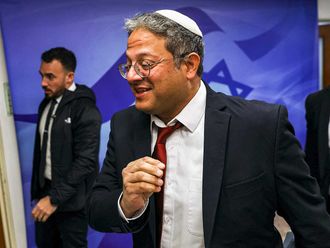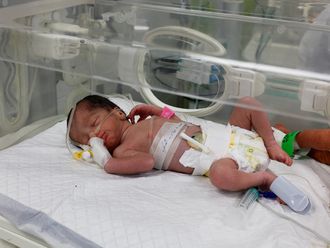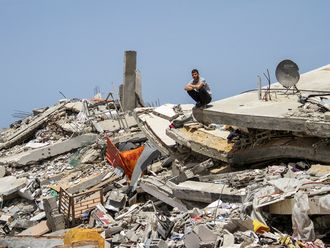
Beirut: Bashar Al Assad has won his war for political survival but as Syria’s conflict enters its ninth year, his country is fractured, cash-strapped, and prey to both friend and foe.
The civil war reaches its eighth anniversary this month with more than a half a million people killed, millions more displaced, and devastation worth $400 billion.
As the war winds down, Syrians in regime-held areas may no longer have to worry about bombardment, but they face fuel shortages, frequent power cuts, unemployment and rampant poverty.
From the brutal repression of anti-Al Assad protests in 2011, the war spiralled into a complex conflict.
Foreign actors
Syria’s president may have reversed the initial gains of the armed opposition, but foreign powers have entered his turf.
“The Syrian conflict is more complicated because there are now powerful foreign actors that control large zones inside Syria,” said Nicholas Heras, an analyst at the Centre for a New American Security.
“And these foreign actors are not likely to leave Syria any time soon.”
Backed by Russia and Iran, Al Assad’s forces now control almost two-thirds of the country.
But key areas remain beyond his control, including a swathe of the oil-rich northeast held by US-backed Kurdish-led forces fighting Daesh.
The northwestern region of Idlib, held by Syria’s former Al-Qaida affiliate, is protected by a ceasefire deal, which has seen Turkish troops deployed to the area.
And Ankara’s Syrian rebel proxies hold several northern cities near the border.
Joshua Landis, of the University of Oklahoma, painted a grim picture.
“The Syrian map is one of division and despair,” he said.
“Over 30 per cent of the country is occupied by foreign governments who have built and funded local militaries.”
Return on investments
Various foreign powers are competing to reap a return on years of military investment, or protect their interests.
Russia has backed Al Assad with troops and air strikes since 2015, while Iran has dispatched advisers as well as Shiite fighters from Lebanon and Iraq.
“Russia wants to stabilise Al Assad to keep a steady local partner to guard its expanding bases in Syria” and project power region-wide, Heras said.
Iran wants a foothold in Syria, in case of a war between its Lebanese ally Hezbollah and Israel to the southwest, he said.
Both allies hope to play a key role in reconstruction and have signed deals including for electricity, oil and infrastructure projects.
Turkey and the United States, who have traditionally backed non-state actors, have other interests.
President Recep Tayyip “Erdogan wants to rip the Kurds out of America’s embrace” and impose Turkey in northern and eastern Syria, Heras said.
Washington backs Kurdish-led fighters who control a large and oil-rich northeastern swathe, and has US troops in Syria as part of the anti-Daesh fight drawing to a close near the Iraqi border.
Turkey views Kurdish fighters as “terrorists” and has long threatened to attack the Kurds south of its border.
Washington is to dial down its presence to 200 “peace-keeping” troops after Daesh is expelled from its last pocket.
As well as shielding the Kurds from Turkey, a US presence piles pressure on Al Assad.
“Al Assad needs the water and wheat that the United States controls in eastern Syria,” Heras said.
But “it is US policy to keep these resources from him and force the economy of Al Assad’s statelet to collapse around him,” he added.
Still under US sanctions
Along with the European Union, the United States has ramped up sanctions on Syrian officials and companies, including by seeking to prevent oil shipments to the country.
Landis said those measures were compounding post-war challenges, chief among them relaunching a devastated economy.
“The US is imposing one of the strictest sanctions regimes on Syria which will continue to deepen the misery of the people,” he added.
Plus “the worst characteristics of the regime have been strengthened in the struggle to win the civil war: corruption, violence, and the absence of the rule of law,” he said.
Shadi Abbas, 40, is struggling to return to a normal life after a routine military service lasted a whole eight years.
“I feel I have to work three jobs” to make ends meet, he said.
“Even if I found some money and work, who will give me back my youth,” he said.
But after years of war, Al Assad has secured his capital, regained control of key commercial arteries, and started a timid comeback on the Arab scene.
Much to the despair of the fragmented opposition, several countries have called for Syria to be reintegrated into the Arab League, from which it was suspended as the death toll mounted in 2011.
Remaining rebels are largely confined to Idlib after being ferried out of other parts of the country retaken by the regime.
The political opposition is scattered abroad and has failed to end the bloodshed in numerous rounds of abortive peace talks.
Whatever the challenges, “revolution is on low flame, and that is a win for Al Assad,” Heras said.

Evolution of the war
From the bloody repression of protests against President Bashar al-Al Assad’s regime to several foreign interventions, here are key dates in eight years of war in Syria:
Revolt, repression
In March 2011 unprecedented protests break out to demand civil liberties and the release of political prisoners, after four decades of repressive rule by the Al Assad dynasty.
The regime cracks down on demonstrations but rallies continue.
In July a defecting army colonel sets up the Turkey-based opposition Free Syrian Army (FSA).
Air strikes, Hezbollah, Iran
In March 2012 regime forces retake control of the third city Homs, which had fallen into the hands of the rebels. It carries out other bloody operations, notably in the central city of Hama, after massive anti-regime protests.
In July FSA fighters launch a battle for Damascus but the government holds firm.
From 2013 regime helicopters and planes unleash barrel bombs on rebel zones.
The same year Iran-backed Lebanese Shiite militant group Hezbollah says it is fighting alongside Syrian government forces.
Iran also boosts its military support for Al Assad, Tehran’s longtime ally.
Rise of Daesh
In June 2014, after clashes with the regime and rebel groups, Daesh proclaims a so-called “caliphate” over territory it has seized in Syria - where Raqqa becomes its de facto capital - and neighbouring Iraq.
In September a US-led coalition launches air strikes against Daesh in Syria.
The strikes benefit Kurdish groups, which since 2013 have run autonomous administrations in Kurdish-majority areas.
Kurds join with Arabs to form the Syrian Democratic Forces (SDF) - backed by the US-led coalition - which goes on to oust Daesh from key areas including Raqqa in October 2017.
Russia to Al Assad’s aid
In September 2015 Russia launches air strikes in support of Al Assad’s troops, who are on the back foot.
Russian firepower helps turn the tables for the regime, which begins to retake rebel-held territory, including second city Aleppo in December 2016.
In January 2017 Syrian regime backers Russia and Iran, and rebel supporter Turkey organise peace talks in Kazakhstan.
The peace efforts eclipse those led by the United Nations.
_resources1_16a30b3514b_original-ratio.jpg)
US strikes
In April 2017 a sarin gas attack on the rebel-held town of Khan Shaikhoun kills more than 80 people.
In retaliation US President Donald Trump unleashes strikes by Tomahawk missiles against the regime’s Shayrat airbase.
The government has regularly been accused of using chemical weapons, which it denies.
Turkish offensive
Turkey launches an operation in January 2018 against the Kurdish People’s Protection Units (YPG), which form the backbone of the SDF alliance.
Ankara is wary of Kurdish aspirations for autonomy. In March it captures the Afrin region, chasing out the YPG which it labels a “terrorist group”.
Blitz of Eastern Ghouta
In February 2018, the Syrian regime launches a ferocious assault on Eastern Ghouta, the final rebel-held enclave near Damascus.
In April the army announces it has retaken the pocket, where more than 1,700 have been killed in the siege.
The same day the United States, Britain and France carry out a wave of punitive strikes in response to an alleged chemical weapons attack on civilians in the Eastern Ghouta town of Douma.
Trump orders troops home
On December 19 Trump orders the withdrawal of the some 2,000 US troops from Syria, saying in a tweet that America had “defeated Daesh”.
The YPG expresses alarm given the threat of a new Turkish offensive on its positions and on December 28 calls on the Syrian army to deploy alongside its own forces in the north.
Daesh last redoubt
On February 2, 2019, the SDF announces it has begun a “decisive battle” to take the last scrap of territory from Daesh at Baghouz in eastern Syria.
Over the next few weeks, tens of thousands of women, children and men - including militants - pour out of the enclave, hampering the US-backed offensive.
On March 13 the SDF says Daesh is in its “final moments” after launching a new bombing blitz on the militants’ last redoubt.












